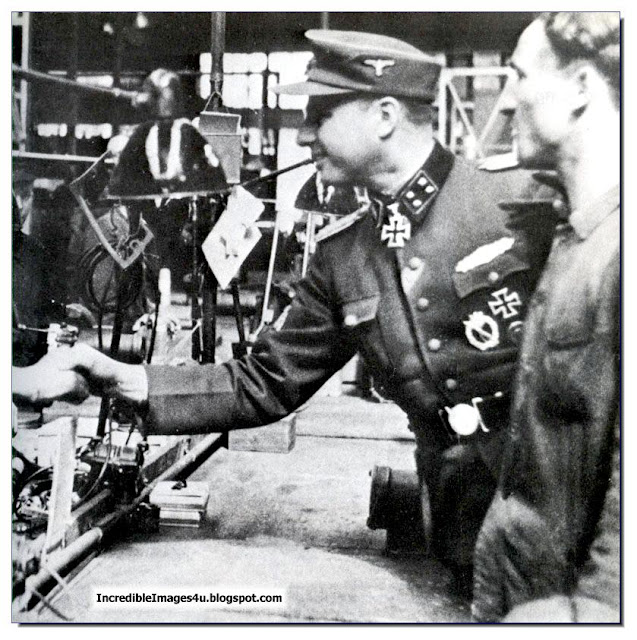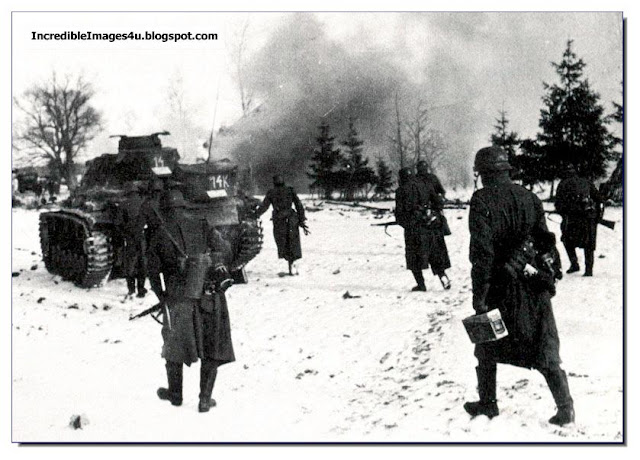SS Panzer Brigade 49 never fully established, existed only on paper. Existed as a fighting unit only on paper.
Legion reorganized in May 1943 as a brigade and designated September 1944 as a division.
Survivors went on 5 May 1945 in British prisoner of war in Schleswig-Holstein .
1943, 2, 1944 with 3, 1945 with 1 motorized infantry regiment. 1943/44 with 14 StuG III and StuG IV , 10 Marder self-propelled anti-tank guns. 24 tanks. 1945 a total of 10 tank destroyer Hetzer .
Some Flemish and Finnish volunteers. Almost completely destroyed at the Oder front in April and May 1945.
Walloon Legion formed in June 1943. Was designated Waffen-SS a division in October 1944 .
Organised by Degrelle.Iin late April 1945 evacuated from the eastern front to Denmark. Later came to British war captivity.
(Also French, Belgian and Spanish volunteers) 1 motorized infantry regiment.1943 with 10 StuG III and StuG IV, 12 Marder self-propelled anti-tank guns. 22 tanks.
Summer 1944: 14 StuG IV, 4 StuH 10.5 cm. 18 tanks. 1945 a total of 10 Jagdpanzer IV
Diie Walloon Brigade was formed in January 1944 with 2,000 men strong . Wallonne and later Belgian volunteers under the command of Leon Degrelle. After the war he fled to Norway then to Spain, where he led a public life for years. Highest combat performance.
'Band' under Bratislaw Kaminski, became Waffen-SS in 1943. Later referred to as 'Division'.
After the withdrawal from the Warsaw Uprising (August 1944), Kaminski was shot dead under mysterious circumstances and his 'Division' dissolved. The Waffen-SS no. 29 was adopted by the Italian No.1 (see next division).
Band of 6,500 men with captured Soviet artillery. Some captured Soviet armored vehicles.
Mostly Ukrainians, wide spread war crimes behind the Central Army Group. During the Warsaw Uprising murdered 10,000 Polish civilians in a day and were withdrawn.
Became the Waffen-SS in September 1944.
Details are not known. The sub-units were used widely scattered.
Operations against partisans in Italy, some clashes with coalition forces.
Formed in July 1944. Became a division of the Waffen-SS in August 1944.
Dissolved and survivors transferred in November 1944 to Vlasov Army ROA .
3 infantry regiments (October 1944).
Consisted of breakaway Russian security forces. Security duties in eastern France, a few skirmishes with allied forces.
Situated in Hungary and Slovakia in October 1944.
Destroyed in Hradec Kralove (Czech Republic) in May 1945 (well below divisional strength)
Mix of foreigners and ethnic Germans, some officers and NCOs of the former 23rd Waffen Mountain Division. Kama .
Was formed in January 1945 from what remained of other units and staff and pupils from SS schools and various other troops. The title of the division comes from the date when Adolf Hitler became the chancellor of Germany on 30 January 1933.
Heavy casualties, only 150 survivors reached the Western Allied as prisoners of war at Tangermünde in May 1945.
3 partially motorized infantry regiments (each with only 2 battalions), 1 Fusilier Battalion. Assault Gun Division with 22 Hetzer. 22 tanks.
Initially, only a battle group of stragglers of various units and soldiers and recruits from various SS Ausbilldungsschulen for formed for immediate use at Frankfurt / Oder. Then expanded to Division.
Formed in 1944/45 Hungary.
Destroyed in Budapest in February 1945. (well below divisional strength)
Hastily put together, largely Hungarian cavalry unit.
The French Volunteer Legion became the Waffen-SS in August 1943. On 10 February 1945 was made a Division.
Parts were evacuated in March 1945 from the fortress Kolberg after Wolin . A battle group defended the government district , where it was destroyed.
1 motorized infantry regiment (with 3 battalions), 1945 a second Infantry Regiment (originally the 638th French Regiment). Pak-self-propelled guns were in the anti-tank company.
Made up of French volunteers and other Western European nations. Also included former French Foreign Legionnaires.
Capitulated in May 1945 against the British.
2 infantry regiments (never reached divisional strength).
Originally formed as a backup unit with Dutch volunteers and German police officers.
Combat mission in Arnhem, later operations against resistance groups in Holland.
Founded in February 1945.
Surrendered to the Red Army in Halbe , May 1945.
3 police, infantry regiments.
Made up of staff from the police training school in Dresden and the SS Junker School Brunswick for use on the Neisse front.
Formed in 1940 as a weak Battalion (Criminal Unit). Between 1942-1944 constantly expanded to brigade-size and ultimately called Division.
The unit was massacred by the Red Army on 29 April 1945 south-east of Berlin. Its longtime commander Dirlewanger (wounded in February 1945) mysteriously died in prison in June 1945.
About 4,000 'butcher' in summer 1944.
Commander Dirlewanger was incarcerated for sex crimes before the war. The staff was recruited from German prisons, concentration camps, SS military prisons and other human "cesspools". Scandalous war crimes , but Dirlewanger, who was personally involved in the terrible atrocities, was Himmler favourite.
Formed in Bratislava in February and March 1945.
Surrendered to the U.S. Army in Austria.
2 cavalry regiments
Formed after the fall of Budapest from the survivors of the eighth and 22nd SS cavalry divisions and other stragglers, including Hungary Hoved Division.
Formed on 28 March 1945 in Freiburg. The Division was still being prepared when it was forced to retire to Bavaria.
Capitulated at Reit im Winkl (Austria) on 4 and 5 May 1945.
1 motorized infantry regiment (3 battalions, fully trained combat troops were deployed in early April 1945). 2 armored-companies (mixed equipment from different tanks and assault guns types). About 28 tanks.
Staff came from SS Junker Infantry School and Bad Tolz, Himmler's bodyguard battalion, 8,000 adolescent volunteers aged 16 or 17-year, and the German part of the disbanded 30th (Russian) Waffen-SS Division.
Suggested Reference
Waffen-SS Handbook, 1933-1945 by Gordon Williamson
Related
Waffen SS Divisons At A Glance: Part 1
Waffen SS Divisons At A Glance: Part 2
Waffen SS Unit Logos
Waffen SS Training: Personal Narrative Of A Recruit
WAFFEN SS IN ACTION: Rare, Unseen Pictures: Part 1
Suggested Reading


























































0 Comments:
Post a Comment